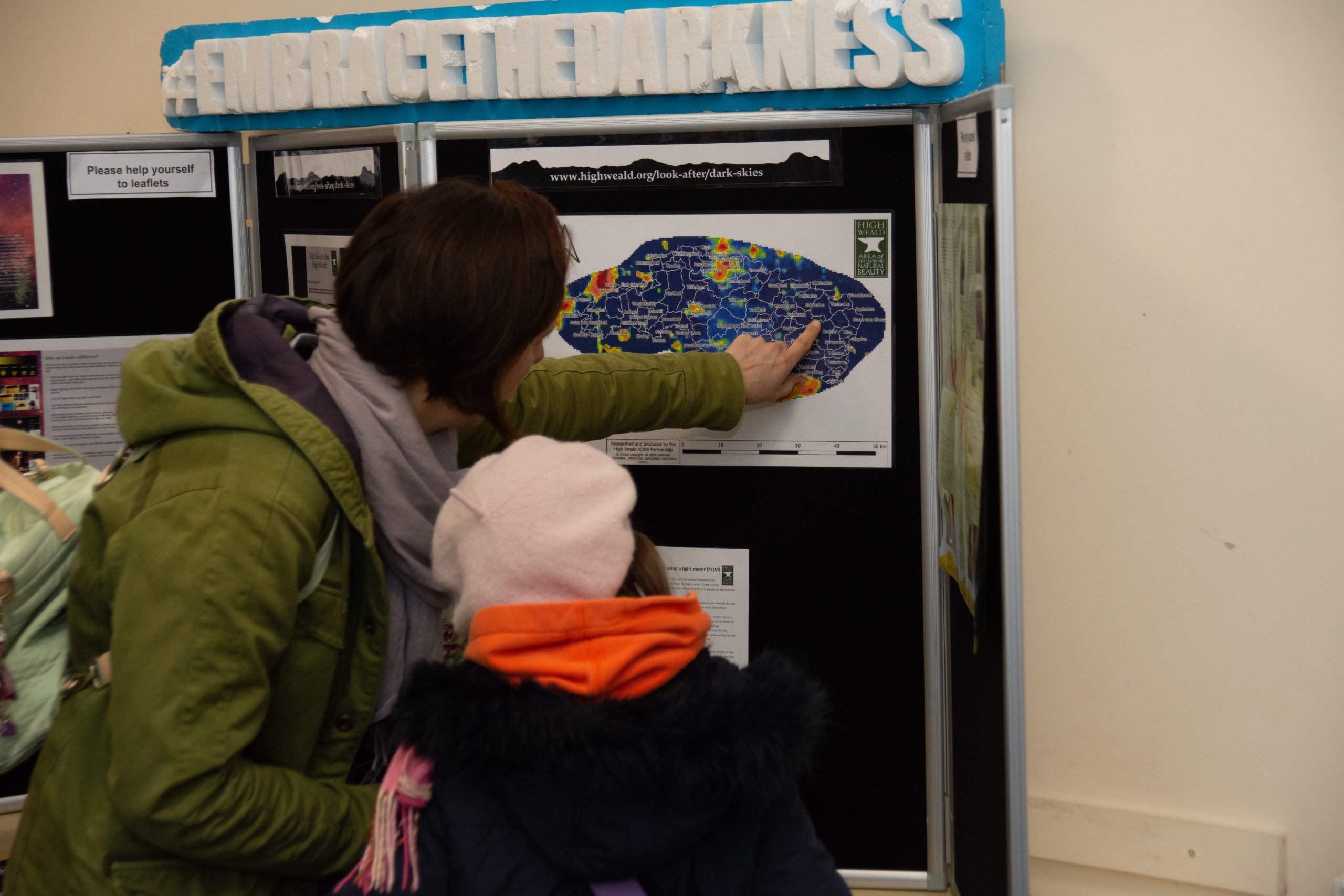Dark Skies
The High Weald is home to some of the darkest skies in the South East. It is an intrinsically dark landscape largely free of interference from artificial light, with breath-taking views of the stars.
This gives the area a sense of remoteness and peacefulness and connects the natural environment to the cultural and historic landscape.
‘Dark Skies’ is one of the eight defining components of the natural beauty of the High Weald set out in the High Weald AONB Management Plan 2024-2029. Learn more here >>.
However, light pollution is a growing issue in the National Landscape. It impacts the area’s precious wildlife, increases carbon emissions, and wastes money. It also affects people’s health and wellbeing, depriving them of a majestic view that has been enjoyed for millennia.
What are Dark Skies?
Dark skies are generally defined as skies relatively free of light pollution where you can see a clear starry sky and importantly, our own galaxy the Milky Way, stretching as a ribbon of faint stars across the sky. Despite the growth and brightening of the region, the skies of the High Weald are of sufficient quality that much of the rural landscape still lies under dark skies where the Milky Way can clearly be seen. This means that we must protect and strive to enhance them for the benefit of wildlife and people alike.
We’re working with communities and local authorities to protect the High Weald’s dark skies. From celebratory events and educational activities to data gathering to support new planning policies, you can get involved.
Join us and help keep our dark skies, dark!
Dark Skies Maps
The High Weald National Landscape Partnership has produced two interactive maps, featuring satellite data readings and Sky Quality Data, to inform dark sky understanding and policy – click the button below to explore them:
What can I do to help?
There are some simple actions you can take to help reduce light pollution in your corner of the High Weald:
- Light just the area you need
- Shield and point lights down
- Choose less bright bulbs
- Use timers and sensors
- Use warm-white bulbs
An easy way to remember is:
Turn it down, Tilt it down, Turn it off!
Download our handy guide to reducing light pollution and share it with your friends and neighbours.


How to get involved:
Wild About Dark Skies Festival
February 2023 saw the first ever Wild About Dark Skies Festival.
Funded by the Sussex Lund grant programme, the Festival raised awareness of the negative impacts of light pollution to our darkest skies within the High Weald Area of Outstanding Natural Beauty. It also celebrated the value of dark skies to wildlife and our own wellbeing – after all, the landscape above our heads is just as important as the landscape beneath our feet.
From Saturday 18 – Sunday 26 February, ‘Wild About…’ community groups in Battle, Burwash, Crowhurst, Etchingham, Ticehurst and Wadhurst came together to run a series of free events across their Parishes, with 63 volunteers at the heart of their success.
Attendees enjoyed planetarium shows, astronomy demonstrations, special guest speakers, light pollution workshops and dark skies storytelling for children.
If you represent a parish or community group in the High Weald and would like to get involved in next year’s Festival, please contact Samantha Nicholas on s.nicholas@highweald.org.
For community groups:
We’re working with local communities to collect light meter readings from across the High Weald to find out where our darkest skies are.
This data will inform our AONB Management Plan and future Dark Skies Policies.
We can loan SQM light meters to communities wishing to assess light levels in their area, and offer simple training via webinar.
Contact s.nicholas@highweald.org for further information.
What can you do?
- Download and distribute our guide to reducing light pollution
- Use dark skies-friendly suppliers when installing lighting on your home or shared community spaces: Dark Sky Lighting.
- Investigate whether you could become an International Dark Skies community.
For Local Authorities and Parish Councils:
Local authorities and parish councils are key in protecting our dark skies.
‘Dark Skies’ is one of the eight defining components of the natural beauty of the High Weald set out in the High Weald AONB Management Plan 2024-2029. Learn more here >>.
The Management Plan highlights key characteristics of dark skies within the High Weald, and key issues, including increasing light pollution in rural areas, sky glow from built up areas adjoining the High Weald AONB, and impacts on local wildlife. The Plan sets out two specific Objectives relating to protecting the dark skies of the High Weald, along with a series of Actions to support these.
We are working to produce a detailed Dark Skies Planning Advice Note to support the Objectives of the Management Plan.
What can you do?
- If you are part of local authority or neighbourhood planning groups’ policy-making, you can produce your own dark skies policy in your Local Plan, which seek to maintain dark skies in rural areas and reduce dark skies light pollution in urban areas in the AONB – you can use the objectives and actions of the Management Plan to help you prepare these policies.
- If you are part of local authority planning decision-making, you can follow the Institute of Lighting Professionals (ILP) guidance on reducing obtrusive lighting, and other relevant guidance to aid protecting dark skies, including ensuring that lighting designers use exterior light control environmental zone E1 to inform any proposed lighting in, or affecting the setting of, the AONB. Guidance Note 1 for the reduction of obtrusive light 2021 | Institution of Lighting Professionals (theilp.org.uk)
- Also ensure decision-making protects wildlife-rich habitats such as ancient semi-natural woodland from external lighting and light spill. Bats and Artificial Lighting at Night – ILP Guidance Note
- Be aware of policy updates at a national level – for example the All Party Parliamentary Group for Dark Skies.
For schools:
Teachers can access Dark Skies resources through our High Weald Hero education programme, including worksheets, quizzes and more.
We also offer a light pollution workshop for KS1 and 2.
There are also opportunities for schools to get involved in the Wild About Dark Skies Festival where children can learn about the wonders of the night sky and how to reduce light pollution in their home and local community.

